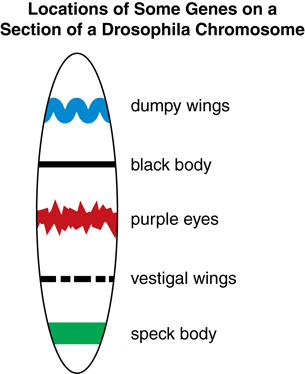Module 6
1. Module 6
1.30. Page 3
Module 6—Mendelian Genetics: The Transmission of Traits to the Next Generation
 Reflect and Connect
Reflect and Connect
By recognizing that genes are located on chromosomes, you can now go far beyond what Mendel was able to do by crossing peas and analyzing outcomes. You should now be able to explain X-linked inheritance, since you know that females have two X chromosomes, and that males have only one. You should also be able to understand that the event of non-disjunction you studied in Module 5 will have dramatic results on offspring by adding or removing thousands of alleles.
Bring your genetic flash cards up-to-date by adding the terms that you have been learning. You may also wish to add entries or flash cards that show patterns of inheritance on one side, with the explanation on the other. To ensure that you have mastered this lesson’s connections to the aspects of genetics that you have already learned, complete the following questions. If you are having difficulty, consult with your teacher.
 Self-Check
Self-Check
Choose one of the following activities.
Choice 1: Go to the Internet and use the terms “biology + Arizona + genetics.” Try the “Sex-Linked Inheritance Problem Set” (1–10). Each problem has a tutorial to help you, and the correct answer is explained.
OR
Choice 2: Answer the following Diploma Exam-style questions.
In humans, the allele for normal blood clotting (H) is dominant to the allele for hemophilia (h). The trait is X-linked.
SC 1. A female hemophiliac marries a man who is not a hemophiliac. Which of the following rows indicates the probability of this couple having a child that is a hemophiliac and indicates the sex that the child would?
| Row | Probability |
Sex of Affected Child |
A. |
0.25 |
male |
B. |
0.25 |
either female or male |
C. |
0.50 |
male |
D. |
0.50 |
either male or female |
SC 2. A woman who is not a hemophiliac has a father who is a hemophiliac. If this woman marries a man who is a hemophiliac, what is the probability of them having a hemophiliac son?
Use the following information to answer SC 3.
A recessive allele causes Drosophila to have white eyes instead of wild-type eyes. This eye colour gene is known to be X-linked. In a cross between homozygous wild-type females and white-eyed males, all F1 progeny have wild-type eyes.
SC 3. What ratio of wild-type to white-eyed progeny can be expected in each sex if F1 females are crossed to males of the same genotype as their father?
- males—1 : 0; females—1 : 0
- males—1 : 1; females—1 : 0
- males—0 : 1; females—1 : 1
- males—1 : 1; females—1 : 1
Use the following information to answer SC 4.

SC 4. To determine whether this is an X chromosome or an autosome, a researcher would have to determine whether these traits are
- recessive
- dominant
- passed from male parents to their male offspring
- passed from female parents to their male offspring
Use the following information to answer SC 5.
Scientists have identified a genetic condition that apparently makes some men prone to impulsive, violent behaviour. A pedigree was drawn highlighting the violent members of a particular family. It appeared, from the pedigree, that men who displayed this violent behaviour inherited this condition from their mothers, not their fathers. Further evidence showed that this was the mode of inheritance.
SC 5. The inheritance pattern described indicates that this condition is
- X-linked
- Y-linked
- autosomal
- codominant
 Self-Check Answers
Self-Check Answers
SC 1. C
SC 2. 0.25 or ![]()
SC 3. D
SC 4. D
SC 5. A
 Reflect on the Big Picture
Reflect on the Big Picture

© Felix Mizioznikov /shutterstock
Would you be worried if all the men in your family were balding? That was a question in the Big Picture. You might be very concerned if you are a male, but not if you are a female.
You know that genes occur on chromosomes, and that males have only one X chromosome, while females have two. This knowledge helps you explain why some traits occur more frequently in males than in females. Males just can’t cover up what’s been given to them by their mothers. Remember that the Y chromosome is virtually “blank.” Any allele on the X chromosome received from the mother will express itself. For females to express an X-linked trait, they must be homozygous recessive. By Mendelian ratios, they have a one in four chance of that happening.
Before beginning your Lesson 6 Assignment, you may wish to do the “Section 17.1 Review” questions on page 598. Your teacher can recommend which questions would be best for you. Discuss your responses with your teacher.
 Module 6: Lesson 6 Assignment
Module 6: Lesson 6 Assignment
Submit your completed Module 6: Lesson 6 Assignment to your teacher for assessment.